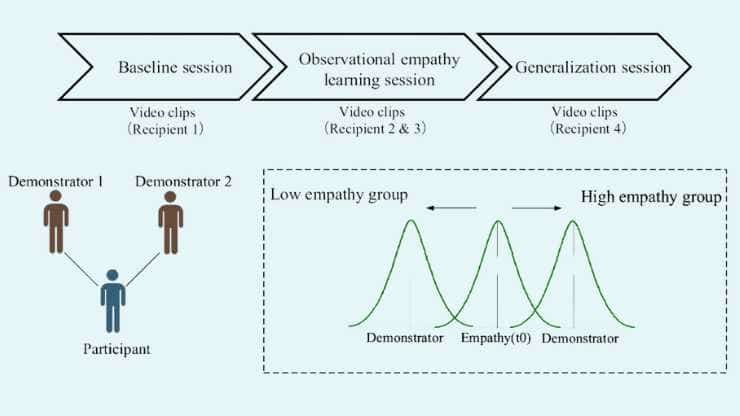In addition to their genetic predispositions, it appears that adults, like children, are able to acquire empathetic reactions from close caregivers. A new study has found that adults can learn to be more or less empathetic by watching others.
Prof. Dr. Grit Hein, professor of Translational Social Neuroscience at the Center of Mental Health of the University Hospital Würzburg (UKW) has managed to capture this complex social phenomenon through mathematical models, a procedure known as Computational Modeling, and has plastically mapped it in the adult brain using functional magnetic resonance imaging (fMRI).
Her findings describe a computational and neurological mechanism for empathy’s social transmission, explaining changes in individual empathic reactions in both empathetic and non-empathic social situations. Grit Hein has essentially formalized the process by which empathy is transmitted.
Social Transmission of Empathy
Hein’s research focused on whether empathy, or lack thereof, for another person’s suffering is socially transmitted. In four investigations, participants first saw films of hands experiencing painful stimulation and then rated their own experiences during the encounter.
After giving their own assessment, they were given other people’s empathetic or non-empathic responses to the identical videos. Finally, participants rated their empathy for a new person’s pain.
Grit Hein and her team were able to use this experimental setup to investigate how and whether a person’s empathy changes in the presence of empathic and non-empathic peers.
By observing the empathic reactions of others, participants learned to be more or less empathetic.
“Empathy ratings increased or decreased depending on whether empathic or non-empathic reactions were observed. Interestingly, the neuronal response to the pain of another person also changed,”
said Grit Hein.
Neural Empathy Changes
The neurological changes detected by the fMRI scanner were reflected in changed connectivity in the anterior insula, a brain region linked with empathy processing. Hein and her colleagues’ findings show that mathematical learning models can explain these brain alterations.
This suggests that increased or decreased empathy is genuinely induced by learning from others, rather than being imitated or displayed for the sake of pleasing others.
Investing in an empathetic environment is beneficial in a working setting. Does this imply that people who want to form a good team must establish a suitable environment?
“Absolutely. It is essential to understand that adults can learn or unlearn empathy through observation, even from individuals they do not know,”
said Grit Hein.
As a result, those who create a work environment devoid of empathy for cost-cutting, time constraints, or mismanagement must be aware that such behavior shapes employees over time and, in turn, influences their interactions with clients or patients.
Mutual Respect is Required
Previous research has found that positive empathy can lead to prosocial motivation, which increases collaboration and readiness to help.
Excessive empathy, on the other hand, can cause stress and, in extreme cases, burnout or withdrawal. Additionally, empathy may be viewed as demanding.
“The good news from our studies is that we have the means to shape empathetic ability in adults through appropriate measures in both directions,” said Grit Hein. “It is possible to learn positive empathy from others. However, for empathy to thrive long-term, it requires an atmosphere of mutual respect. One can respect someone without having empathy for that person, but it is challenging to develop empathy if the other person is not respected as a human or if disrespect is accepted in society.”
Grit Hein concentrates her research on complicated social relationships. To comprehend these connections, it is necessary to begin very simply, establish the core mechanics, and then progressively include social variables like puzzle pieces. As a result, the current investigation was conducted entirely with female participants.
However, the social empathy transmission effect was repeated in multiple settings (MRI and laboratory) and with female participants of varying ages and races. Both younger and older European and Asian participants gave comparable responses.
Later studies on empathy that include mixed genders are an interesting approach. Grit Hein is currently investigating if the model can be extended to other social tendencies, such as selfishness or aggressiveness.
Abstract
Theories of moral development propose that empathy is transmitted across individuals. However, the mechanisms through which empathy is socially transmitted remain unclear. Here, we combine computational learning models and functional MRI to investigate whether, and if so, how empathic and non-empathic responses observed in others affect the empathy of female observers. The results of three independent studies showed that watching empathic or non-empathic responses generates a learning signal that respectively increases or decreases empathy ratings of the observer. A fourth study revealed that the learning-related transmission of empathy is stronger when observing human rather than computer demonstrators. Finally, we show that the social transmission of empathy alters empathy-related responses in the anterior insula, i.e., the same region that correlated with empathy baseline ratings, as well as its functional connectivity with the temporoparietal junction. Together, our findings provide a computational and neural mechanism for the social transmission of empathy that accounts for changes in individual empathic responses in empathic and non-empathic social environments.
Reference:
- Zhou, Yuqing et al. The social transmission of empathy relies on observational reinforcement learning. Proceedings of the National Academy of Sciences of the United States of America vol. 121,9 (2024): e2313073121. doi:10.1073/pnas.2313073121
Image: The main experiment consisted of the baseline session, observational empathy learning session, and the generalization session. In each session, participants viewed video clips of different recipients receiving electrical stimulation. The mean pain intensity ratings of recipients were comparable across recipients as indicated by a pilot stimulus validation study. Credit: PNAS vol. 121,9 (2024): e2313073121. doi:10.1073/pnas.2313073121
